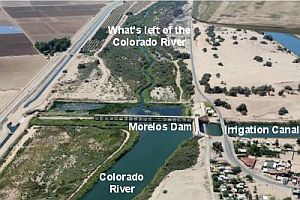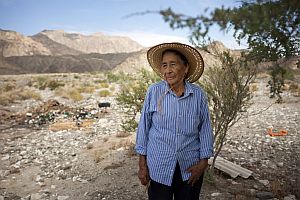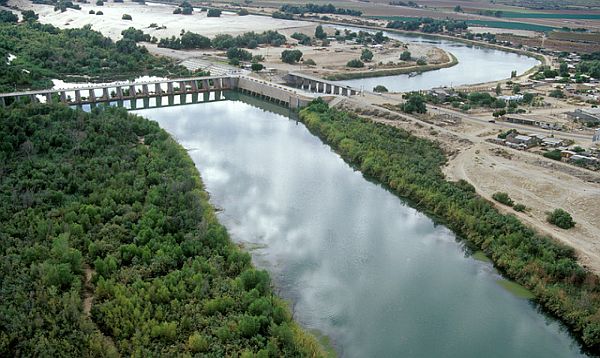Los Algodones, Mexico - A river bled dry by thirsty cities and farms in two countries will flow once again through northern Mexico later this month in an international experiment in habitat restoration.
Beginning March 23rd, the last dam on the Colorado River will open its gates to unleash a man-made flood that is scheduled to last eight weeks and send more than 100,000 acre-feet of water to its parched delta in Mexico’s northwestern Baja California state, the biggest flood in decades.
The so-called "pulse flow event" is meant to replicate what was once a rite of spring on the Colorado before the river was dammed and its surge of snowmelt diverted to crops and suburbs and massive reservoirs such as Lake Mead.
Under the watchful eyes of researchers from a bi-national scientific team, the initial flood from Morelos Dam — a mile south of where California, Arizona, and Mexico adjoin — will build and then ebb through May 18th. The goal is to spur growth along the river channel, which historically harbored native, flood-adapted willow and cottonwood trees.
That will be followed by a small but steady stream of "base flows," eventually totaling more than 52,000 acre-feet, meant to keep the channel wet as the riparian habitat struggles back to life.
One acre-foot is enough to supply two average valley homes for a little more than a year. Nearly all of Nevada’s annual share — 300,000 acre-feet — goes to the Las Vegas Valley, which draws about 90 percent of its water from Lake Mead.
The pulse flow was made possible by a 2012 amendment to a 70-year-old treaty between the United States and Mexico. The amendment, Minute 319, spells out how Mexico will share in shortages and surpluses, and it allows that nation to store water in Lake Mead for future use. Nevada, Arizona and California do the same.
The Source
All the water to be released from Morales Dam in the coming weeks belongs to Mexico, or at least used to.
 |
| The Colorado River comes to a full stop at the Morales Dam near Los Algodones, Mexico - it hasn't flowed all the way to the Gulf of California since 1960 |
It’s water Mexico otherwise could have used for farms or cities, said John Entsminger, general manager of the Southern Nevada Water Authority.
Technically, the released water does not come out of the 1.5 million acre-feet Mexico gets each year from the Colorado River. The pulse flow will come from system credits the country earns by improving the efficiency of its water infrastructure.
"We support it," Entsminger said of the flow experiment and the treaty amendment as a whole. "We got a lot of benefits out of that."
The largest gain comes from Mexico’s ability to store more water in Lake Mead, something that helps keep the reservoir from shrinking enough to shut down intake pipes. Nevada also expects some actual water through the agreement.
In exchange for a three-year, $2.5 million investment in Mexican infrastructure, the water authority has been promised a one-time share of 23,700 acre-feet from the savings Mexico expects to generate from lining leaky canals and more efficient crop irrigation.
Under Minute 319, the United States also agreed to invest $21 million in Mexican infrastructure to "save" enough water to cover about half of the upcoming pulse flow.
Conservationists on both sides of the border pushed for the treaty amendment to include some way to restore the flow of water to the delta, and they hail the upcoming release from Morelos Dam.
"The pulse flow is a vital part of our ongoing restoration efforts," Francisco Zamora Arroyo, director of the Colorado River Delta Legacy Program at Sonoran Institute, said in a statement. "We know that relatively small amounts of water can make a big difference in the health of the delta region."
Osvel Hinojosa, Water and Wetlands Program Director for the conservation group Pronatura Noroeste, said some 380 bird species are expected to benefit from the return of water to the delta.
"So will the local Mexican farming communities that long-ago watched the Colorado River delta dry up," Hinojosa said.
 |
| A local woman stands in the dry Colorado River Delta of northwestern Mexico. The Morelos Dam last released a significant amount of water in 1983. |
As part of Minute 319, the trust is responsible for securing the 52,000 acre-feet of base flows that will keep some water in the river after this spring’s flood.
End of the River
By the time the Colorado reaches the US-Mexico border, some 1,400 miles from its headwaters high in the Rocky Mountains, nearly all of its flow has been diverted to agricultural operations in Southern California and Arizona and to residents in Denver, Las Vegas, Los Angeles, San Diego, Phoenix, and Tucson.
What’s left of the river comes to a full stop at the Morales Dam, where it is channeled southwest to crops and communities in Mexico’s Mexicali Valley.
Jack Simes, area planning officer for the US Bureau of Reclamation in Southern California, said regular water flow to the Gulf of California ended in 1960. Morelos Dam last released a significant amount of water in 1983, when record flooding on the Colorado caused Lake Mead to spill for the first time ever.
How much water usually gets past Morelos Dam and into the old river channel? "Other than seepage, none," Simes said.
The 105,000 acre-feet to be released during the pulse represents less than 1 percent of the river’s flow in an average year, but it should be enough to reconnect the Colorado to the sea — temporarily.
If advocates hope to restore the flow for good, they will have to persuade users to consume less and cooperate even more.
Original Story


